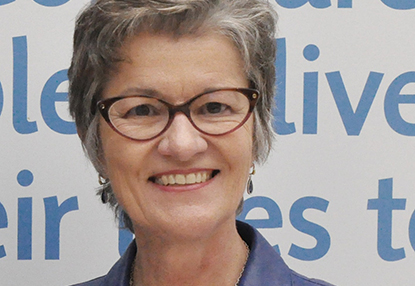Expert Explainer for World Diabetes Day: Dr. Irene Hramiak on advances in diabetes care

World Diabetes Day is marked every year on November 14 to draw attention to issues of paramount importance to the diabetes world. While there have been major advances in diabetes care in the last century, rates of diabetes continue to rise globally and cause lasting health impacts.
Dr. Irene Hramiak is a professor and renowned researcher specializing in diabetes at Western University’s Schulich School of Medicine & Dentistry, an endocrinologist at St. Joseph’s Health Care London and a scientist with Lawson Health Research Institute. She explains how diabetes care has evolved over the past 100 years and how research continues to provide better quality of life for patients.
What is diabetes?
Diabetes is a problem with metabolism, and in particular, how the body handles sugar, which is one of the primary energy sources that we all need in our cells. There are two kinds of diabetes: type 1 diabetes often onsets in people under the age of 40, often children or young adults, and requires insulin as the mainstay of treatment. The other kind, which is more prevalent, is type 2 diabetes and that typically onsets in people over the age of 40, although more recently we are seeing it onset in younger people. This diabetes often starts off because people have a genetic disposition, a sedentary lifestyle, and have gained weight initially. We can often treat this with lifestyle changes, such as becoming more active and eating a healthier diet. The next step is oral tablets for management; insulin may be necessary after many years.
It is estimated that about nine per cent of all Canadians have diabetes; approximately one per cent of all Canadians have type 1 diabetes, and the remainder have type 2 diabetes. It is also a disease that gets worse as you age, so in people over the age of 70, type 2 diabetes may be as common as 20 per cent of the population.
 How does diabetes affect a person’s quality of life?
How does diabetes affect a person’s quality of life?
Diabetes requires a lot of work on the part of the patient, on a daily basis, to manage their disease; food, medication, and monitoring. Their management plan includes paying attention to what they eat and how they prepare meals; taking medication, which may be in the form of oral tablets or insulin, and requires a regimen to take medication properly; as well as monitoring their blood sugars, which depending on what their treatment plan is, a person with diabetes may have to monitor every time they eat, just once a day, or a couple of times a week.
How has diabetes care changed in the last fifty years?
All aspects of diabetes treatment have changed.
When a person was first diagnosed 50 years ago, they weren’t allowed to eat a lot of carbohydrates because we didn’t have the tools at that time to manage their blood sugar as well. Advances in blood sugar management have allowed the diet to become much more liberal and give people with diabetes a broader approach to their diet.
Our therapies have improved tremendously; we have newer insulins that are safer and easier to take, such as an insulin pen. If you were delivering insulin 50 years ago, it was with a syringe that you had to boil on your stove.
Another major advancement has been in flash monitoring, which is a new way to monitor blood sugar without pricking the fingers; it provides a record of the blood sugar continuously so we can see fluctuations and changes.
I think for me, one of the most important therapy changes has been some of the new oral tablets we have available for type 2 diabetes. Type 2 diabetics are often older patients for whom insulin and managing insulin is problematic and we worry about them having low blood sugars, so having new tablets that are effective and safe to take have been a great innovation.
We also have something called GLP-1 analogs, which is another type of hormone-glucagon-like peptide that you take by injection; it does not cause low blood sugars and does not require the dose changes of insulin; it can be safer and easier to take for the type 2 diabetic patient.
What does the future of diabetes care look like?
Preventing diabetes is a worthwhile strategy; as such, part of the future of diabetes care will involve developing good treatments for obesity beyond bariatric surgery.
Unfortunately, throughout the world, obesity has continued to increase and if we can find a good medical therapy for obesity, we might be able to prevent, or at least delay, the onset of type 2 diabetes.
In addition, we have new insulins in development that are glucose-sensing insulin molecules, which means that if your blood sugar is low, the insulin stops working; this is an amazing advancement.
I’m always optimistic that eventually we will find a cure for type 1 diabetes. Type 1 may be easier to cure because type 2 has many causes, so it’s harder to find a single solution.
If we can find a way to clone islets and package those islets so they are safe and we don’t need immunosuppression, we could then potentially cure type 1 diabetes; there are many researchers who are working on these solutions around the world.
What has been London, Ontario’s contribution to advances in diabetes research and care?
London’s role in diabetes management all started on October 31, 1920 at 2 a.m., when Dr. Frederick Banting had an idea about isolating insulin from the pancreas and maybe using that for treating diabetes.
Since then, there have been many physicians and researchers in London who have been working on improving care for people with diabetes.
I have been involved with colleagues here in London in a clinical trial called the Diabetes Control and Complications Trial (DCCT), sponsored by the National Institute of Health (NIH) that included 1500 type 1 diabetics. Thirty-eight years later and that trial is still ongoing, looking at a very select group of patients. It has taught us so much. It has taught us that blood sugar control is important for preventing complications. It has taught us how to manage type 1 diabetes, and it has informed the widespread use of insulin pumps, which can now connect to continuous glucose monitors (CGM) and form a Hybrid Closed Loop (HCL) automated system. This involves a sensor connected to an insulin pump that turns the pump off when blood sugar is dropping and increases insulin delivery in the pump when the blood sugar is higher than it should be. This is a very sophisticated technological solution for type 1 diabetes that is a huge innovation from pumps in the early era in the 1980s.
I’m very grateful to the people in the London region. We have had so many volunteers and research subjects that have given us their time and energy and enthusiasm to do that kind of ground-breaking work.








